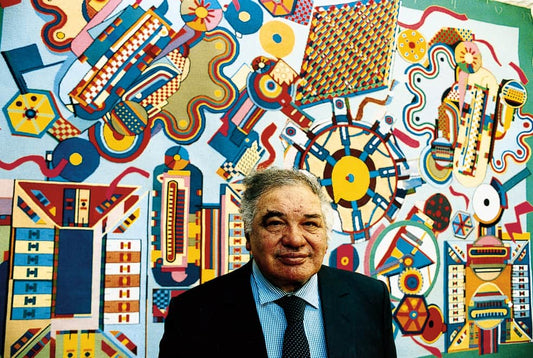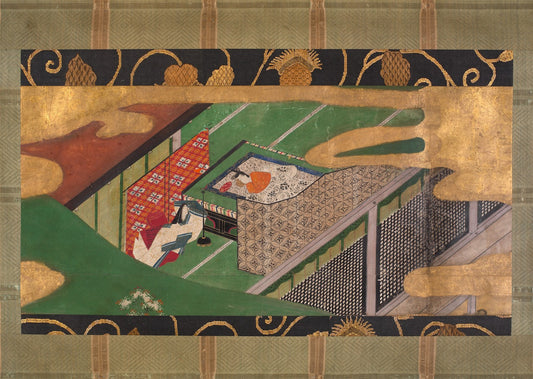Feature image: Sun Yuan and Peng Yu via The Allure of Matter
Sun Yuan and Peng Yu: Controversy in the Conceptual
You might know their work but not their names. Chinese conceptual art duo Sun Yuan and Peng Yu have been pushing the envelope of acceptable morality within art since the late 1990s. Known for their use of materials such as living and dead animals, human cadavers, machinery, and otherwise unconventional props in their highly provocative, intimate works, Sun and Peng have been called “the artists China can’t keep contained.”
Learn why the duo’s art has been condemned and celebrated and what they’re trying to say about our world’s most paradoxical and political relationships.

Background
Sun Yuan was born in 1972 in Beijing, China, and Peng Yu was born in 1974 in Heilongjiang, China.
Both attended the Central Academy of Fine Arts in Beijing at the same time, with Peng three years ahead of Sun. The pair also attended Central Academy for university. Peng and Sun graduated with a focus in oil painting in 1998 and 1995, respectively.
Sun and Peng were married in 2000. In 2001, the now husband-and-wife received the Chinese Contemporary Art Award.
Can’t Help Myself (2016-2019)
The duo is perhaps most well-known to Western audiences for one of their recent works, Can’t Help Myself. Commissioned for the Guggenheim Museum in New York City, the exhibition ran from 2016 to 2019.
The piece—which, in a way, is more performance than concept—consisted of a KUKA industrial robot with a modified arm that was employed to do one thing: contain the red, viscous liquid oozing from its base within a small area around itself. The robot was also built with visual-recognition sensors, allowing it to dynamically react to its environment.

When the robot senses that the liquid, which is cellulose ether in colored water, has strayed too far from its designated area of containment, the arm will frantically scramble to sweep up the fluid, inevitably making an even bigger mess of its surroundings. Red stains can be seen on the floors and walls of the robot’s enclosure. Videos of Can’t Help Myself captured the robot in action, with its harsh, mechanical whirring being the only sound scoring the experience.
In the early months of the exhibition, viewers noted that the robot appeared to be “happy” doing its task, with its movements being very animated and whimsical. The visual-recognition sensors within the robot also allowed it to “dance” for passersby. Sun and Peng worked with two robotic engineers to design 32 unique movements for the robot to perform. The names the pair chose for some of these movements—“scratch an itch,” “bow and shake,” and “ass shake”—further serve to personify the robot.
“Observed from the cage-like acrylic partitions that isolate it in the gallery space, the machine seems to acquire consciousness and metamorphose into a life-form that has been captured and confined in the space,”
The robot ran continuously after its debut in 2016, dutifully attempting to clean the liquid as best as it could. Time, of course, took its toll, and by 2019, the robot was painfully slow-moving, appearing to be overwhelmed and exhausted from performing its programmed actions for so long. The liquid was splattered everywhere within the robot’s confines, the deep red invoking imagery of blood and violence.
A video from 2017, just a few months into the exhibition, shows just how much the robot had already deteriorated by that time. Commenters note how the noises of the machinery sound like “screams of pain.” In 2019, the exhibition officially ended when Sun and Peng walked into the gallery space to unplug their creation, putting an end to the robot’s Sisyphean efforts.
The Can’t Help Myself robot quickly went viral across social media, with many offering their interpretations and analyses of what the exhibit meant. Some view the robot’s plight as a representation of a struggle with mental illness, self-harm, depression, or obsessive-compulsive disorder. The title has a double meaning in this regard, referring to the subject as someone who cannot help themselves to get better but also cannot help themselves from indulging in destructive behaviors. Others saw the robot as a commentary on work, labor, and capitalism, with the robot being forced to do a monotonous task until it effectively “killed” itself by doing so.

Whatever the interpretation, it's generally agreed upon that Can’t Help Myself is one of the most eerily disturbing, violent pieces of conceptual art without actually featuring graphic depictions. In a 2019 essay titled Sun Yuan and Peng Yu: Audience, Agency, and Complicity, author Cecily Chen features Can’t Help Myself in conversation with pieces from fellow conceptual/performance artists Félix González-Torres and Marina Abramović.
Sun and Peng view Can’t Help Myself as a work that examines “our increasingly automated global reality” and is meant to be a commentary on migration, border control, and the surveillance and control of border zones across the world.
“Such visceral associations call attention to the consequences of authoritarianism guided by certain political agendas that seek to draw more borders between places and cultures and to the increasing use of technology to monitor our environment,” explains Weng.

Can’t Help Myself cements itself as a remarkable piece of modern art that’s still being discussed today, due to its subjectivity and the variety of interpretations it invokes, but Sun and Peng want to ensure that its original message is a political one. The human emotions that are projected onto the robot undermine the artists’ view of their work, with the pair wanting to represent the harm automation and technology can do when placed in the hands of governments willing to use it for control through forms of violence.
Ultimately, Can’t Help Myself is a piece about relationships. Intended to be a critique of the relationships between nations and surveillance, the public response to Can’t Help Myself serves as a meta-commentary of the viewer’s relationship with technology.
“In this world, whether the relationships are people to people, people to nation, nation to nation, people to objects, or people to animals —they are all political,”
Before Can’t Help Myself, Sun and Peng were always interested in using visceral, dramatic imagery to make a statement. Of course, the pair hasn’t been free from controversy for doing so. But the duo’s earlier polarizing (though less heralded) works are arguably what allowed them to find such success with Can’t Help Myself.
“I am concerned with whether the viewer is able to break their existing moral boundaries when looking at our work,” Sun said in 2018. “What is the function of morality?”

Other Works and Controversy
All kinds of organic materials have been used in various forms of art throughout history. Bodily fluids like urine, sweat, saliva, semen, and blood are utilized more often than one might think, but the more intense materials Sun and Peng have previously used in their conceptual works have crossed a line that goes far beyond what many of those in the Western world would consider acceptable, even for art’s sake.
In 2003, the pair showcased their piece entitled Dogs That Cannot Touch Each Other. This work featured eight pit bull terriers, four directly facing the other four, running on non-motorized treadmills towards each other. At first, while remaining stationary, each dog’s view of the dog facing them was blocked with a clipboard, so they could not see the other dog. Then, once the clipboard was removed, the dogs began to run at one another. The dogs were chained to their treadmills via a harness, ensuring that they would never be able to reach the other dog in front of them, hence the work’s title.
The dogs’ handlers were present at the time of the performance, and the dogs were only allowed to run for seven minutes before the clipboard was replaced and they were given a break. With this work, Sun and Peng “allowed us to look beyond the cruel reality of pit bull fighting and revealed an existing potential for violence and confrontation,” according to Gu Zhenqing in an article for Sun and Peng’s website.
While the public performance was originally showcased in Beijing in 2003, the Guggenheim Museum faced heavy criticism from animal rights activist groups such as PETA for featuring a seven-minute video of Dogs That Cannot Touch Each Other in a 2017 exhibition titled Art and China after 1989: Theater of the World. The video was eventually pulled from the exhibit, with the museum making a statement in September 2017, assuring the public that no actual dog fighting occurred within the video or the original 2003 performance.
Defenses of the work were quickly dispatched in response to the controversy, noting that while the piece relies on the use and exploitation of animals, detractors fail to contextualize the time in which the piece was created and the precautions taken during the original piece’s debut.

Sun and Peng’s pre-Can’t Help Myself works have faced controversy for their material content and overt political imagery. In Old People’s Home (2007), 13 hyperrealistic, life-sized replicas of world leaders are seated in motorized wheelchairs that move about the gallery space on their own, only changing directions when they run into walls or another wheelchair. This work presents the absurd humanity of those who are given the power to make complex, important global decisions and how they, too, will eventually grow old and need assistance, just like the rest of us.


Body Link (2000) is another one of Sun and Peng's performance pieces that some view as deeply morally and ethically questionable. In the work, Sun and Peng both injected 100 cubic centimeters of their own blood into the corpse of a conjoined twin. This work was performed shortly after Sun and Peng decided to get married. Human Oil (2000), a solo work from Peng Yu, also features a human cadaver.
Curtain (1999), a solo work by Peng, and Aquatic Wall (1998), a solo work by Sun both feature live marine and reptilian animals. These two pieces by each duo member show that Sun and Peng wanted to push moral boundaries from the very start of their careers.
“The audiences’ feedback is exactly the thing I care about,” Sun responded when asked in an interview with Xu Tan if he and Peng cared about negative audience feedback.
“But it’s not important how they respond to our works, as long as there is [a] response at all,” Peng added. “We don’t really care whether they are positive or negative, we care about the fact that they do have [a] reaction.”
Conclusion
Deeply transgressive art will always spark debate among artists and viewers alike, but throughout their prolific careers, Sun Yuan and Peng Yu have proven over and over again that it pays to take risks that lead to thought-provoking works that take a stand on dark, inherently polarizing aspects of our society.
Yuan and Yu’s subversive works have undoubtedly fostered various interpretations of their meanings and whether they should exist at all, but rest assured, Sun and Peng know exactly what they’re doing. And they’re not stopping any time soon.
©ArtRKL™️ LLC 2021-2024. All rights reserved. This material may not be published, broadcast, rewritten or redistributed. ArtRKL™️ and its underscore design indicate trademarks of ArtRKL™️ LLC and its subsidiaries.







